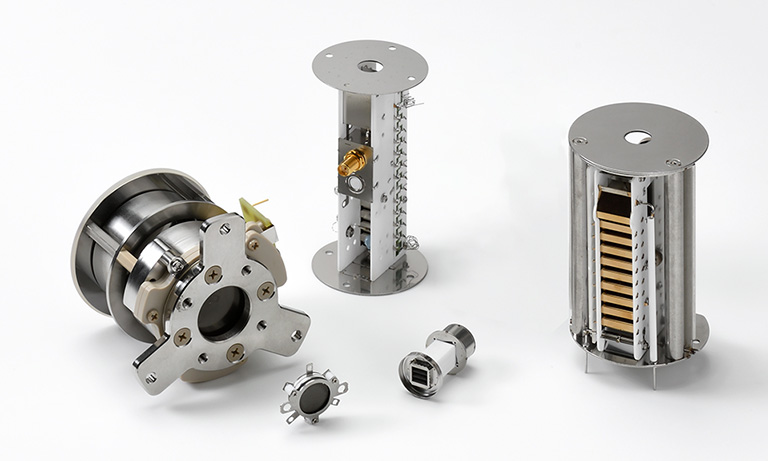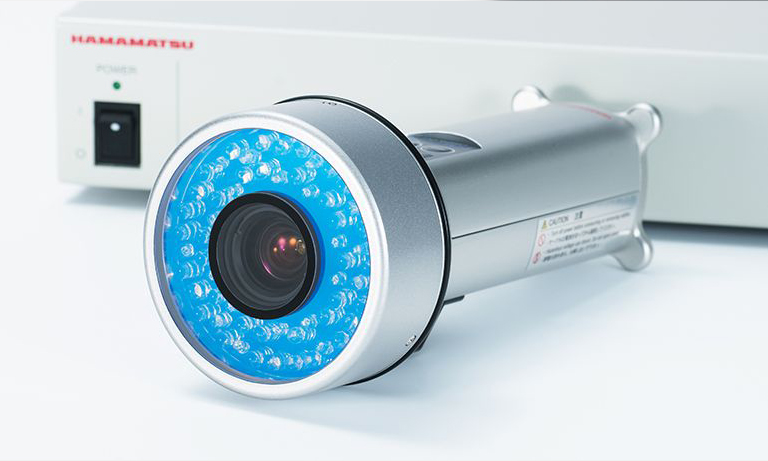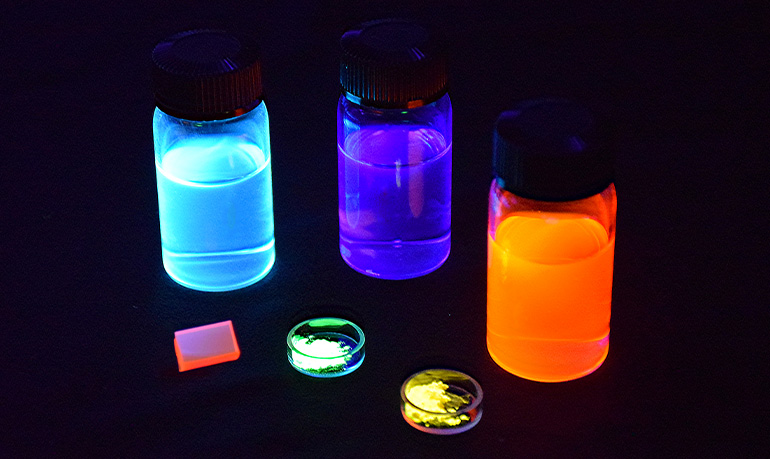Japan (EN)
Select your region or country.


What is MPPC® (SiPM)? | MPPC (SiPMs) / SPADs
What is MPPC (SiPM)?
MPPC is short for Multi-Pixel Photon Counter, and this detector is also known as silicon photomultiplier (SiPM). It is a solid state photodetector that uses multiple avalanche photodiode (APD) pixels operating in Geiger mode. More details and a comparison of different photodetectors are below.
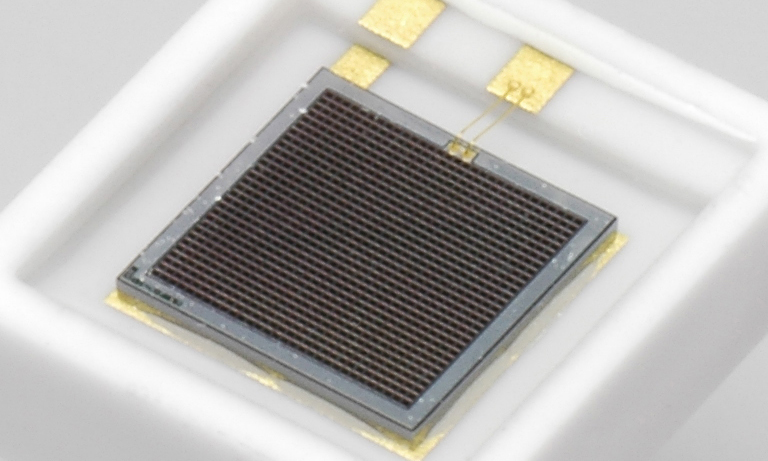
Structure
The structures of SPAD and MPPC are shown below.
SPAD is configured with one pixel, in which a Geiger mode APD and a Quenching resistor are combined as one set. MPPC is configured with a plurality of pixels, in which said SPADs are arranged in plural numbers and electrically connected in parallel.
Structure
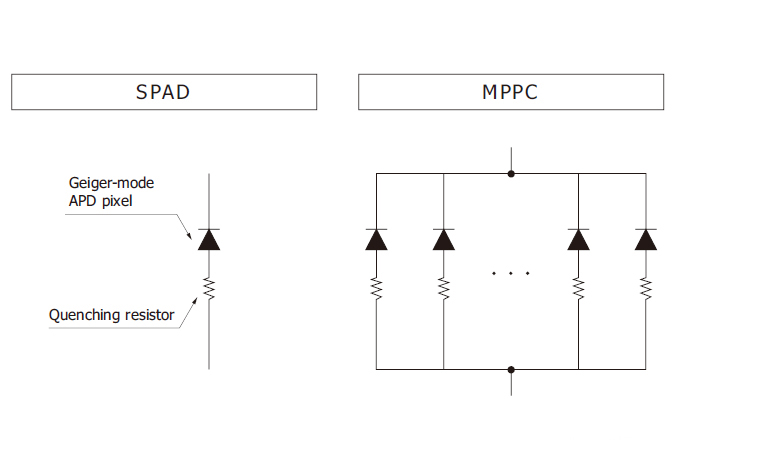
Image of MPPC's photon counting
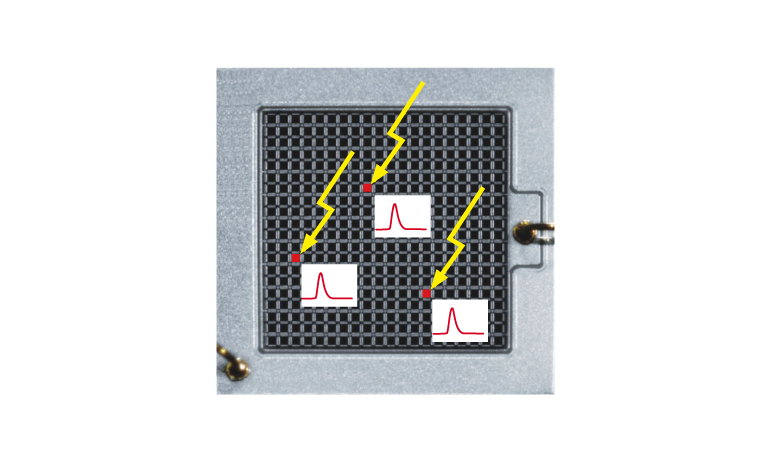
Basic operation
Each pixel in the MPPC outputs a pulse at the same amplitude when it detects a photon. Pulses generated by multiple pixels are output while superimposed onto each other. For example, if three photons are incident on different pixels and detected at the same time, then the MPPC outputs a signal whose amplitude equals the height of the three superimposed pulses. Each pixel outputs only one pulse and this does not vary with the number of incident photons. So the number of output pulses is always one regardless of whether one photon or two or more photons enter a pixel at the same time. This means that MPPC output linearity gets worse as more photons are incident on the MPPC such as when two or more photons enter one pixel. This makes it essential to select an MPPC having enough pixels to match the number of incident photons. The following two methods are used to estimate the number of photons detected by the MPPC.
(1) Observing pulses
When light enters an MPPC at a particular timing, its output pulse height varies depending on the number of photons detected. Figure shows output pulses from the MPPC obtained when it was illuminated with the pulsed light at photon counting levels and then amplified with a linear amplifier and observed on an oscilloscope. As can be seen from the figure, the pulses are separated from each other according to the number of detected photons such as one, two, three photons and so on. Measuring the height of each pulse allows estimating the number of detected photons.
Pulse waveforms when using a linear amplifer
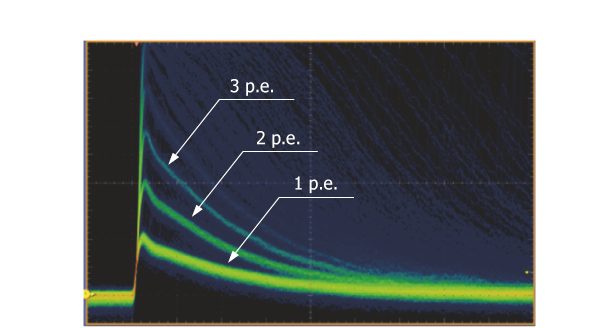
(2) Integrating the output charge
The distribution of the number of photons detected during a particular period can be estimated by measuring the MPPC output charge using a charge amplifier or similar device. Figure shows a distribution obtained by discriminating the accumulated charge amount. Each peak from the left corresponds to the pedestal, one photon, two photons, three photons and so on. Since the MPPC gain is high enough to produce a large amount of output charge, the distribution can show discrete peaks according to the number of detected photons.
Pulse height spectrum when using charge amplifier
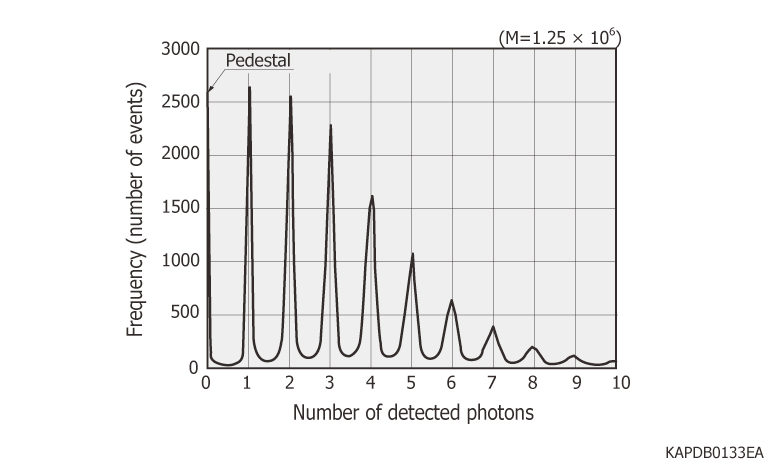
How to use
The MPPC characteristics greatly vary depending on the operating voltage and ambient temperature. In general, raising the operating voltage increases the electric field inside the MPPC and so improves the gain, photon detection efficiency, and time resolution. On the other hand, this also increases unwanted components such as dark count, afterpulses, and crosstalk which lower the S/N. The operating voltage must be carefully set in order to obtain the desired characteristics.
The MPPC can be used by various methods according to the application. Here we introduce a typical method for observing light pulses. Using a wide-band amplifier and oscilloscope makes this measurement easy. Figure shows one example of a connection to a wide-band amplifier. The 1 kΩ resistor and 0.1 μF capacitor on the power supply portion serve as a low-pass filter that eliminates high-frequency noise of the power supply. The 1 kΩ resistor is also a protective resistor against excessive current.
The MPPC itself is a low-light-level detector, however, in cases where a large amount of light enters the MPPC, for example, when it is coupled to a scintillator to detect radiation, a large current flows into the MPPC. This may cause a significant voltage drop across the protective resistor, so the protective resistor value must be carefully selected according to the application. The amplifier should be connected as close to the MPPC as possible.
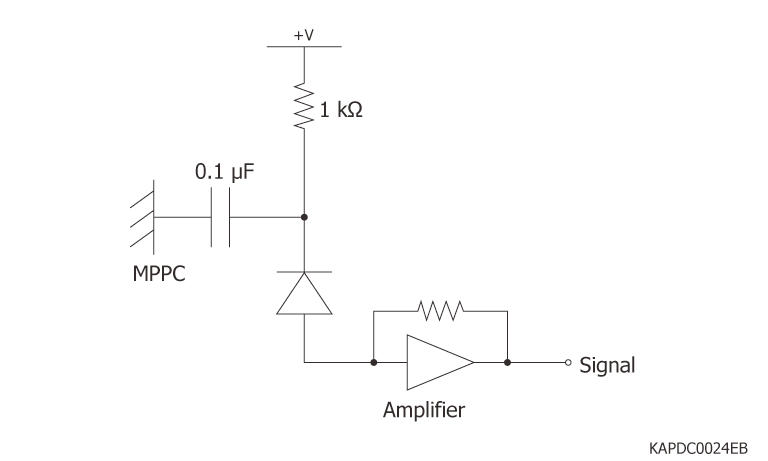
Characteristics
| PD | APD | MPPC | PMT | |
|---|---|---|---|---|
| Gain | 1 | 102 | to 106 | to 107 |
| Quantum efficiency | Highest | High | Medium | Low |
| Operation voltage | 5 V | 100 to 500 V | 30 to 60 V | 800 to 1000 V |
| Large area | No | No | Medium | yes |
| Multi channel with narrow gap |
Yes | Yes | Yes | No |
| Readout circuit | Complex | Complex | Simple | Simple |
| Noise | Low | Middle | Middle | Low |
| Uniformity | Excellent | Good | Excellent | Good |
| Energy resolution | High | Medium | High | High |
| Temperature sensitivity | Low | High | Medium | Low |
| Ambient light immunity | Yes | Yes | Yes | No |
| Magnetic resist | Yes | Yes | Yes | No |
| Compact & Weight | Yes | Yes | Yes | No |
- Confirmation
-
It looks like you're in the . If this is not your location, please select the correct region or country below.
You're headed to Hamamatsu Photonics website for JP (English). If you want to view an other country's site, the optimized information will be provided by selecting options below.
In order to use this website comfortably, we use cookies. For cookie details please see our cookie policy.
- Cookie Policy
-
This website or its third-party tools use cookies, which are necessary to its functioning and required to achieve the purposes illustrated in this cookie policy. By closing the cookie warning banner, scrolling the page, clicking a link or continuing to browse otherwise, you agree to the use of cookies.
Hamamatsu uses cookies in order to enhance your experience on our website and ensure that our website functions.
You can visit this page at any time to learn more about cookies, get the most up to date information on how we use cookies and manage your cookie settings. We will not use cookies for any purpose other than the ones stated, but please note that we reserve the right to update our cookies.
1. What are cookies?
For modern websites to work according to visitor’s expectations, they need to collect certain basic information about visitors. To do this, a site will create small text files which are placed on visitor’s devices (computer or mobile) - these files are known as cookies when you access a website. Cookies are used in order to make websites function and work efficiently. Cookies are uniquely assigned to each visitor and can only be read by a web server in the domain that issued the cookie to the visitor. Cookies cannot be used to run programs or deliver viruses to a visitor’s device.
Cookies do various jobs which make the visitor’s experience of the internet much smoother and more interactive. For instance, cookies are used to remember the visitor’s preferences on sites they visit often, to remember language preference and to help navigate between pages more efficiently. Much, though not all, of the data collected is anonymous, though some of it is designed to detect browsing patterns and approximate geographical location to improve the visitor experience.
Certain type of cookies may require the data subject’s consent before storing them on the computer.
2. What are the different types of cookies?
This website uses two types of cookies:
- First party cookies. For our website, the first party cookies are controlled and maintained by Hamamatsu. No other parties have access to these cookies.
- Third party cookies. These cookies are implemented by organizations outside Hamamatsu. We do not have access to the data in these cookies, but we use these cookies to improve the overall website experience.
3. How do we use cookies?
This website uses cookies for following purposes:
- Certain cookies are necessary for our website to function. These are strictly necessary cookies and are required to enable website access, support navigation or provide relevant content. These cookies direct you to the correct region or country, and support security and ecommerce. Strictly necessary cookies also enforce your privacy preferences. Without these strictly necessary cookies, much of our website will not function.
- Analytics cookies are used to track website usage. This data enables us to improve our website usability, performance and website administration. In our analytics cookies, we do not store any personal identifying information.
- Functionality cookies. These are used to recognize you when you return to our website. This enables us to personalize our content for you, greet you by name and remember your preferences (for example, your choice of language or region).
- These cookies record your visit to our website, the pages you have visited and the links you have followed. We will use this information to make our website and the advertising displayed on it more relevant to your interests. We may also share this information with third parties for this purpose.
Cookies help us help you. Through the use of cookies, we learn what is important to our visitors and we develop and enhance website content and functionality to support your experience. Much of our website can be accessed if cookies are disabled, however certain website functions may not work. And, we believe your current and future visits will be enhanced if cookies are enabled.
4. Which cookies do we use?
There are two ways to manage cookie preferences.
- You can set your cookie preferences on your device or in your browser.
- You can set your cookie preferences at the website level.
If you don’t want to receive cookies, you can modify your browser so that it notifies you when cookies are sent to it or you can refuse cookies altogether. You can also delete cookies that have already been set.
If you wish to restrict or block web browser cookies which are set on your device then you can do this through your browser settings; the Help function within your browser should tell you how. Alternatively, you may wish to visit www.aboutcookies.org, which contains comprehensive information on how to do this on a wide variety of desktop browsers.
5. What are Internet tags and how do we use them with cookies?
Occasionally, we may use internet tags (also known as action tags, single-pixel GIFs, clear GIFs, invisible GIFs and 1-by-1 GIFs) at this site and may deploy these tags/cookies through a third-party advertising partner or a web analytical service partner which may be located and store the respective information (including your IP-address) in a foreign country. These tags/cookies are placed on both online advertisements that bring users to this site and on different pages of this site. We use this technology to measure the visitors' responses to our sites and the effectiveness of our advertising campaigns (including how many times a page is opened and which information is consulted) as well as to evaluate your use of this website. The third-party partner or the web analytical service partner may be able to collect data about visitors to our and other sites because of these internet tags/cookies, may compose reports regarding the website’s activity for us and may provide further services which are related to the use of the website and the internet. They may provide such information to other parties if there is a legal requirement that they do so, or if they hire the other parties to process information on their behalf.
If you would like more information about web tags and cookies associated with on-line advertising or to opt-out of third-party collection of this information, please visit the Network Advertising Initiative website http://www.networkadvertising.org.
6. Analytics and Advertisement Cookies
We use third-party cookies (such as Google Analytics) to track visitors on our website, to get reports about how visitors use the website and to inform, optimize and serve ads based on someone's past visits to our website.
You may opt-out of Google Analytics cookies by the websites provided by Google:
https://tools.google.com/dlpage/gaoptout?hl=en
As provided in this Privacy Policy (Article 5), you can learn more about opt-out cookies by the website provided by Network Advertising Initiative:
http://www.networkadvertising.org
We inform you that in such case you will not be able to wholly use all functions of our website.
Close










